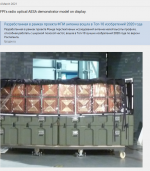Bro, I don't think I have compared it with F35. With its high power generation capacity, uniquely capable sensor fusion engine, mutliple implemented extensive upgrade cycles already, F35 leads any platform in class by a wide margin.
That reply was mostly for @Strong AI Who raised questions about where J35's avionics could stand in comparison to American 5th gen standard.
I simply said - if your engine can't match the American standard, then your avionics can't either.
Because one is tied to the other.
However, we did had discussions on F35's power generation specifically on KAAN thread. Afaik, it has three generators 80kw each. One is reserved so it is 160kw in average. I am not sure where did you get 400kva, any source? Perhaps a new development. Though, I did read the news of RTX upgrading its EPACS to 80kw cooling capacity. Which, as you say is enormous.
160 was a very early configuration, it was then upgraded to 300 and then 400 as electrical demand went up.
It's going to increase further as engine upgrade is coming up.

Pentagon pressing ahead with F-35 engine upgrade
The US Department of Defense is affirming its commitment to delivering an engine upgrade for the Lockheed Martin F-35 stealth fighter, with a recent $1.3 billion contract to propulsion supplier Pratt & Whitney to fund continued development of the initiative.
"The goal of the ECU programme is to improve the capacity of the F-35’s existing single engine to provide electrical power and cooling to onboard systems."
As for AESA sensor, I remember we talked about it a year ago or so. But from what I know now, GaN vs GaAs doesn't matter that much. It is much more about the design of TRM itself, antenna design=gain/directivity, digital beamforming, processing unit, etc. (I.e. you can still make shitty GaN based AESA compared to APG-81) Let's say even if you increase the transmission power output by 100% utilizing powerful GaN TRMs, you will only get an increase in range by roughly 20%. (From what I read, efficiency improvement is minor. Highly efficient GaAs TRM are also designed and manufactured today) So you improve the detection range by putting more TRM and having a bigger array, according to 'AESA radar calculator' developer. By increasing the numbers of TRM and antenna by 100%, you get an 68% increase in detection range (assuming we are using the same TRMs+antenna without changing the other factors, as duty cycle or the environment) On another forum he gave this very simplified equation.
Rfac = ((1200/1200)^3*(10/10))^(1/4)
Rfac = 1
Rfac = ((1200/1200)^3*(20/10))^(1/4)
Rfac = 1.19
Rfac = ((2400/1200)^3*(10/10))^(1/4)
Rfac =1.68
DOWNLOAD-AESA Radar calculator V3.
Though, I can see why GaN array is more lucrative in EW applications. I.e. due to its significantly high transmission output capacity. That's probably why APG-85 EA capabilities is going to be insane.
GaN starts to matter when & if you actually have the ability to take advantage of its higher output capacity. Otherwise it represents a very marginal improvement in capability.
Currently only F35 is equipped to truly make use of GaN's potential.











